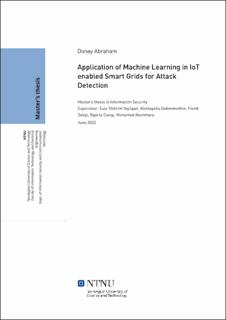| dc.contributor.advisor | Yayilgan, Sule | |
| dc.contributor.advisor | Gebremedhin, Alemayehu | |
| dc.contributor.advisor | Dalipi, Fisnik | |
| dc.contributor.advisor | Elezaj, Ogerta | |
| dc.contributor.advisor | Abomhara, Mohamed | |
| dc.contributor.author | Abraham, Doney | |
| dc.date.accessioned | 2021-09-23T19:05:56Z | |
| dc.date.available | 2021-09-23T19:05:56Z | |
| dc.date.issued | 2020 | |
| dc.identifier | no.ntnu:inspera:56390147:34393349 | |
| dc.identifier.uri | https://hdl.handle.net/11250/2781124 | |
| dc.description.abstract | Smarte strømnettsløsninger har blitt anvendt i større grad i nyere tid for kritisk infrastruktur med tanke på testing og utprøving i både stor og liten skala. Slike strømnettsløsninger kombinert med IoT har potensiale til å fungere sammen innenfor ulike områder, som eksempelvis ekstern overvåking og styring av strøm, trafikal teknologi, parkeringsbransjen og til og med tidlig deteksjon av strømtilstrømninger forårsaket av naturkatastrofer. De ovenfornevnte eksemplene understreker flere fordeler med slik teknologi, men utover dette finnes det eksempler på sikkerhetstrusler og diverse farer for å ikke ivareta ulike personvernhensyn, avsløre hemmelig informasjon osv. Videre kan smarte strømnettsløsninger være utsatt for dataangrep som kan føre til at hele infrastrukturen svikter, skader på tjenesteleverandører (feks økonomiske tap) og individer (personvern).
Denne masteroppgave tar for seg forskjellene mellom tradisjonell strømnettteknologi og smart strømnetteknologi med IoT-aktiverte enheter samt hvordan bruk av et smart rutenett kan fasilitere kostnadsbesparelser ved å minske operasjonelle kostnader, styre energiforbruk og problemløsning i sanntid.
For det første omhandler oppgaven også forskjellige måter slik teknologi er sårbar for ulike angrep samt anomalideteksjonsmetoder ved bruk av maskinlæring for å oppdage angrepene og anomaliene for IoT-aktiverte smarte strømnett. For det andre fokuserer oppgaven på hvordan en smart strømnettslønsing påvirkes når IoT og smarte enheter er tilkoblet nettet. For det siste tar avhandlingen for seg hvordan personvern påvirkes ved bruk av IoT i smarte strømnett. | |
| dc.description.abstract | Smart Grids have been increasingly used these days in terms of critical infrastructure when considered in a large scale and in other small areas of operations. This coupled with IoT has huge potentials in several areas like remotely monitoring and managing electricity, traffic signs, traffic congestion, parking spaces, road warnings and even early detection of things like power influxes as the result of natural disasters like earthquakes and extreme weather. Besides the advantages as mentioned, there are increase in security and privacy threats such as unauthorized access, disclosure of information, Denial of Service (Dos) attacks, among others. The smart grids could be prone to security attacks which can cause the entire infrastructure to be offline (DoS) and can cause severe damages to service provider (e.g., lost of money) and individuals (e.g., compromising of privacy).
This thesis discusses about the differences between a traditional grid and a smart grid with IoT enabled devices and how using a smart grid can help in saving money by lowering the operational cost, managing energy consumption and real time troubleshooting. It also focuses on various attack and anomaly detection methods using machine learning to detect the attacks and anomalies in IoT enabled smart grids. Discussions on how the behaviour of a smart grid changes when IoT or smart devices are connected to it have been conducted as part of the study. The thesis also investigates how privacy is affected with the introduction of IoT in smart grids. | |
| dc.language | | |
| dc.publisher | NTNU | |
| dc.title | Application of Machine Learning in IoT enabled Smart Grids for Attack Detection | |
| dc.type | Master thesis | |
